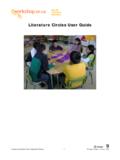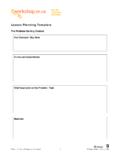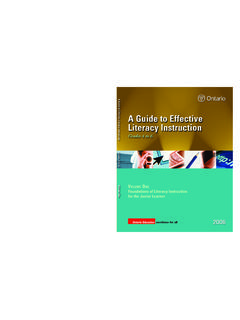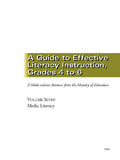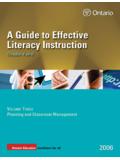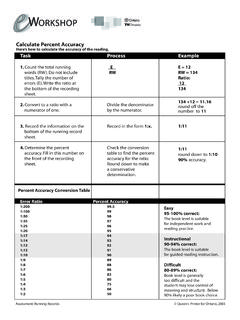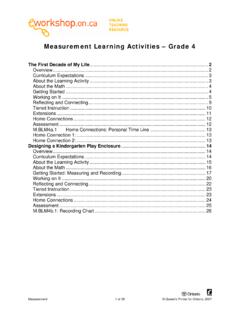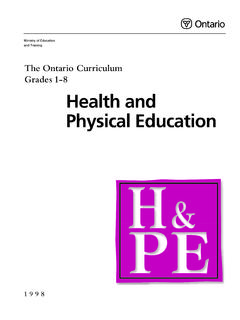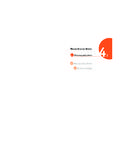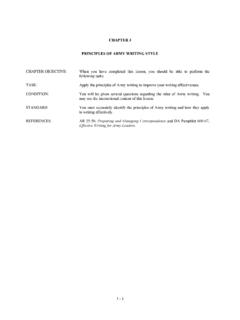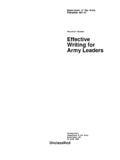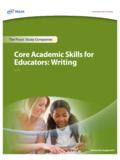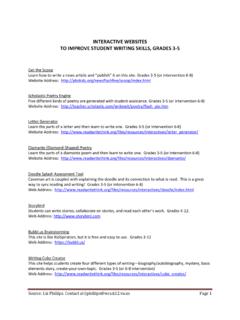Transcription of © Queen’s Printer for Ontario, 2005 04-319 ISBN 0 …
1 Ministry of Education Printed on recycled paper ISBN 0-7794-8184-4. 04-319 . Queen's Printer for Ontario, 2005. Kindergarten to Grade 3. Contents Preface .. vii Organization and Features of This guide .. vii 1. Overview of effective Instruction in writing .. Introduction .. The Goals of writing Instruction .. The Stages of writing Development .. Becoming an effective Writer .. Five Key Instructional Approaches .. Setting High Expectations for All Students .. The Role of Technology in writing Instruction .. Planning and Classroom Organization .. A Framework for effective Early writing Instruction .. Thumbnails of Appendix .. Appendix 1-1: Some Suggested Picture Books for Teaching the Elements of writing References .. 2. Modelled writing .. The Frequency of Modelled writing .. The Role and Responsibilities of the Teacher in Modelled writing .
2 Teaching Points .. Sample Lessons Sample Modelled writing Lesson: Kindergarten .. References .. Une publication quivalente est disponible en fran ais sous le titre suivant : guide d'enseignement efficace de l' criture, de la maternelle la 3e ann e. 3. Shared writing .. The Frequency of Shared writing .. Roles and Responsibilities in Shared writing .. Similarities and Differences in Shared and Interactive writing .. Teaching Points .. Sample Lessons Sample Shared writing Lesson: Grade 2 .. References .. 4. Interactive writing .. The Frequency of Interactive writing .. Roles and Responsibilities in Interactive writing .. Teaching Points .. Sample Lessons Sample Interactive writing Lesson: Grade 1 .. References .. 5. Guided writing .. The Frequency of Guided writing .. Roles and Responsibilities in Guided writing .
3 How Group Members Are Selected .. Teaching Points .. Activities for the Rest of the Class .. Sample Lessons Sample Guided writing Lesson: Grade 2 .. References .. 6. Independent writing .. The Frequency of Independent writing .. Roles and Responsibilities in Independent writing .. Independent writing and the writing Process .. Sample Lessons Sample Independent writing Lesson: writing Workshop, Grade 3 .. Sample Independent writing Lesson: Persuasive writing , Grade 3 .. iv A guide to effective Instruction in writing , Kindergarten to Grade 3. Thumbnails of Appendices .. Appendix 6-1: writing Workshop Where We're At Chart Appendix 6-2: writing Workshop Where I'm At Chart Appendix 6-3: Sample writing Conference Record Appendix 6-4: Independent writing Revising and Editing Checklist Appendix 6-5: writing Self-Assessment Form Appendix 6-6: Persuasive Letter Planner Appendix 6-7: Persuasive Letter Revising and Editing Checklist References.
4 7. Assessment and Evaluation .. Categories of Assessment .. Assessment Strategies and Tools .. Assessment Criteria .. Exemplars .. Assessing writing Across the Curriculum .. Report Card Evaluation of writing .. Thumbnails of Appendices .. Appendix 7-1: writing Interview Form Appendix 7-2: writing Skills Checklist Appendix 7-3: Portfolio Assessment Forms References .. Glossary .. Contents v Preface A guide to effective Instruction in writing , Kindergarten to Grade 3, 2005 is designed to provide classroom teachers of Kindergarten to Grade 3 with practical approaches and resources for delivering an effective writing program. The document is intended to supplement A guide to effective Instruction in Reading, Kindergarten to Grade 3, 2003, published by the Ontario Ministry of Education. Research indicates that, because reading and writing are interdependent, students'.
5 Learning in one area supports their learning in the other. This guide complements and builds on material in the reading instruction guide , to help teachers plan programs that will enhance students' overall literacy development. Organization and Features of This guide This guide has seven chapters. Chapter 1 provides an overview of effective writing instruction. Subsequent chapters address the five key instructional approaches of an effective writing program: modelled writing , shared writing , interactive writing , guided writing , and independent writing A final chapter discusses assessment and evaluation. A glossary of terms used in this guide is provided at the end of the document. Supplemental appendices accompany several of the chapters. The appendices contain various kinds of information and tools intended for use with the teaching approaches and strategies outlined in the text.
6 Thumbnail images of these appendices are provided in this guide ; the full-sized versions can be downloaded from the eWorkshop website, at vii Overview of 1. Chapter Contents effective Instruction in writing Introduction .. The Goals of writing Instruction .. The Stages of writing Development .. The Emergent Writer .. The Early Writer .. Developing Fluency .. Student Attitudes Towards writing .. Becoming an effective Writer .. The writing Process .. The Elements of writing .. Text Forms, Genres, and Formats .. Five Key Instructional Approaches .. Setting High Expectations for All Students .. Teaching writing to English As a Second Language/. English Literacy Development (ESL/ELD) Students .. The Role of Technology in writing Instruction .. Planning and Classroom Organization .. A Framework for effective Early writing Instruction.
7 Thumbnails of Appendix .. Appendix 1-1: Some Suggested Picture Books for Teaching the Elements of writing References .. Overview of effective Instruction in writing Introduction Readers and writers are involved in similar activities. Readers create meaning for groups of words based on their knowledge and experiences. Writers take ideas, thoughts, and emotions and transfer them onto paper (or a computer screen) using their knowledge of language conventions and the writing process to create meaningful text. These activities are embedded in all aspects of the curriculum. Since both reading and writing focus on meaning, development in one reinforces progress in the other: students learn to read and write better The interconnectedness when the two processes are linked. As in teaching reading, writing of reading and writing teachers use a balance of modelling, direct instruction, guided instruc- is profound and tion, and facilitation of students' independent learning and practice.
8 Inescapable . Fragmenting these Critical literacy plays an important part in both reading and writing . complex literacy It encourages students to become actively engaged with the text as they processes interferes make connections to their prior knowledge, other texts, and the world with the greatest goal around them. It also encourages them to move beyond the text as they ask of literacy education . questions about the author's purpose and make inferences, evaluations, the construction of and judgements. meaning from and writing is a powerful instrument for students to use to express their through text. Using thoughts, feelings, and judgements about what they have read, seen, reading and writing or experienced. As students continue to develop an understanding together in harmonious of the writing process; the elements of writing ; text forms, genres, concert enables learners and formats; and technology, they are able to express themselves to draw on these more confidently and effectively.
9 Complementary processes at the same Teachers use their professional judgement and careful observation in time as they work to order to provide explicit instruction that will support students as they construct meaning.. become effective writers. (Fountas and Pinnell, 2001, p. vi). Because of the interconnectedness of reading and writing , this guide builds on material already presented in A guide to effective Instruction in Reading, Overview of effective Instruction in writing Kindergarten to Grade 3 (Ontario Ministry of Education, 2003;. This guide builds on material hereafter referred to as the guide to effective Instruction in Reading presented in A guide to or, simply, the reading instruction guide ). For example, Chapter 3, effective Instruction in Oral Language and Reading , explains oral language development Reading, Kindergarten to and its relationship to reading and writing , while Chapter 10, Grade 3, 2003, which is often The Role of writing in Reading Instruction , addresses the referred to in this document interrelatedness of reading and writing and provides specific simply as the reading examples of ways in which writing supports reading and reading instruction guide .
10 Supports writing . It is hoped that teachers will refer to these and other chapters in the reading instruction guide as they familiarize themselves with this writing guide . There are five key instructional approaches to writing modelled writing , shared writing , interactive writing , guided writing , and independent writing each of which forms the subject of a later chapter. Each approach provides opportunities for oral language instruction and practice, and each chapter contains one or more sample lessons that can be used for planning purposes or as a source of new ideas. First, however, this overview examines the understandings teachers must have to successfully deliver an effective writing program. Teachers need to understand the goals of writing instruction, the stages of development writers pass through, the strategies used by proficient or good writers, and the knowledge and skills students require to become effective writers.
